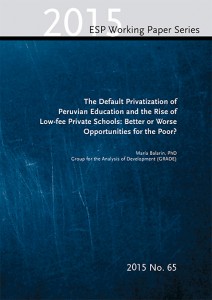The default privatization of peruvian education and the rise of low-fee private schools: better or worse opportunities for the poor?
| Year | : | 2015 |
|---|---|---|
| Author/s | : | Maria Balarin |
| Area/s | : | Education and learning |
Balarin, M. (2015). The Default Privatization of Peruvian Education and the Rise of Low-fee Private Schools: Better or Worse Opportunities for the Poor? PRIDI. ESP Working Paper Series, 65.
The study on which this paper is based set out to explore what was happening in the lowfee private schooling sector in Perú—a growing and un-explored area of public education in the country and in many parts of the developing world—and, more specifi cally, at how parents from poor backgrounds make decisions and navigate the low-fee private schooling market. The project ended up being much more comprehensive than I had originally envisaged, partly because the very little available information on low-fee private schooling in Perú required mapping privatization trends at a broader level, but also because, as I went along, a number of issues, notably with regard to the regulation of the private school market, began to emerge that were relevant not only to low-fee private schooling, but to the phenomenon of private education as a whole. While the project kept a focus on poor families who send their children to low-fee private schools, it developed into an exploration of the much broader phenomenon of ‘privatization by default’ that has taken place in the country over the past two or three decades.
This paper will focus on these two aspects of educational privatization: how the process of default privatization has taken place in an extremely weak regulatory context, and how families from poor backgrounds make decisions about sending their children to low-fee private schools. Framing the case study are a set of more conceptual refl ections drawn from the literature on how markets in education work and how some of the trends identifi ed in more institutionalized—better regulated, publicly funded—educational markets might deepen in a much more weakly institutionalized context like that of Peru (Balarin 2008). The study’s fi ndings challenge uncritical accounts of low-fee private education which portray it as an area of hope and greater opportunities for poor families, and raises serious questions with regard to the way in which this form of privatization might be intensifying educational segregation while misleadingly capitalizing on the hopes and dreams of the poor.







